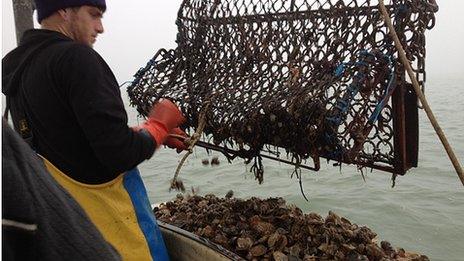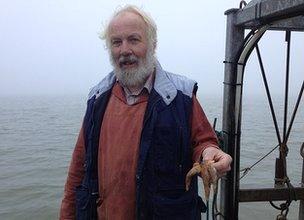'Eat UK oysters' scientists urge
- Published

Only a few beds lie scattered round the UK's coastline
Scientists attempting to revive the UK's ailing native oyster beds are urging people to carry on eating oysters, despite calls to the contrary.
They say oyster beds will only be restored if there's the economic driver of demand for oysters on the plate.
The issue is being addressed at a conference at St Catharine's College, Cambridge, on Tuesday.
Britain's oyster beds are thought once to have smothered much of the bed of shallow areas of the North Sea.
They have never recovered from devastating over-fishing in the 19th Century when the railways carted shellfish to Dickens' booming London.
Only a few beds remain scattered round the coasts now and the total area is estimated to have been reduced by perhaps more than 90% - some scientists think 99%.
Scientists say that reduction has directly contributed to a drop in fish catches through changes to the ecosystem. The jagged oyster beds create a habitat for spawning fish, prey fish and fish food like polychaete worms and baby crabs.
They also filter sea water - up to three litres an hour, external - which improves the habitat for sea grasses, which in turn provide shelter for breeding fish. And they slow down waves, helping to protect vulnerable coastlines.
A few good schemes
"There are a suite of benefits that oyster beds bring," says Cambridge biologist Philine zu Ermgassen, one of the conference organisers.
"From the USA we have good evidence that if you improve oyster beds, you see an increase in fish stocks. These benefits have been recognised and there is a lot of funding from the National Oceanic and Atmospheric Administration (NOAA) and local authorities for a major programme to restore oyster beds.

Richard Haward has seen stocks of the famous Colchester oyster steadily decline
"There are a few good schemes in the UK but we want to see if there's scope for a very big increase in this programme."
The native oyster is suffering from multiple assaults, external, including disease (especially Bonamia), siltation, invasive species, and a predator - the oyster drill, which does what it says on the shell. The introduced Pacific rock oyster can compete with native oysters too, although fishermen say it generally tends to favour shallower waters.
Reproduction of the native oyster is also compromised because in many areas individuals are too dispersed.
In Chichester, fishing crews are working with local authorities and Wildlife Trusts to tackle this problem by lifting solitary oysters from sparsely-populated areas of the sea floor and introducing them to their fellows on a single densely-packed bed.
The hope is that this mat - protected from fishing - will produce oyster larvae, known as spat, that will re-colonise other areas.
Dr zu Ermgassen told BBC News that the definition of an oyster bed, external set by Ospar (the mechanism established to protect the marine environment of the North-East Atlantic) is five oysters per square metre - enough to allow recruitment, but not to build the habitat. "An oyster bed needs to be a thickly-populated mat. That increases the height of the bed and increases the strength of the current which mean that the bed is self-cleaning because silt is taken away."
The dire situation in the UK mirrors a global trend. Perhaps 85% of oyster reefs round the world have been lost, external.
Lost habitat
Dr zu Ermgassen has been studying a restoration programme in the USA, external, where 500 hectares a year are being recreated with public money. The technique involves coating the sea bed with culch - oyster shells recycled from restaurants and shucking houses. If this is unavailable, crushed limestone or clam shells are spread to furnish young oysters with a calcareous substrate to cling to.
The Wildlife Trusts are strongly supportive of similar moves in the UK. Sarah Allison from the Essex branch told me: "This is a massive habitat that we've lost. Just because it's under the water people don't see it, but it is a real loss to our ecosystem. We believe we can get some success in restoring native oyster beds."
In Essex some native oyster beds have been closed because they are so depleted. But Dr zu Ermgassen said many of the scientists at the meeting in Cambridge (sponsored by The Nature Conservancy) say this is active conservation management rather than a signal for people to stop eating oysters.
"Some people seem to be advocating that we shouldn't eat native oysters - we wouldn't agree with that at all because we need to have an economic rationale for the beds," she said.
But, she said, there was impetus on government too. "The UK has international commitments to restoring the native oyster. It is a Biodiversity Action Plan priority species. To meet these obligations it's clear that the habitat has to be not just protected but restored. There has been progress on this already but we're hoping to gain momentum to push this further forward."
She admitted, though, that it would be harder to resurrect oyster beds in the UK where there is insufficient spat, than in the US where there is plenty of spat but insufficient culch.
It is all coming rather late for oystermen like Richard Haward, who has seen stocks of the famous Colchester oyster steadily decline on his patch on Mersea Island in Essex.
In 1865 one historian noted that three men in a boat off a British port could procure 3,000 oysters in a couple of hours.
When I visited Haward, his oyster dredge hauled up just a quarter of a bucket of native oysters in three attempts. The vast majority of Haward's "catch" was the unwanted invader, the slipper limpet Crepidula fornicata.
"Native oysters are just a very small fraction of our business nowadays," he told me. "It's very sad because its our history in these parts."
Follow Roger on Twitter @rogerharrabin, external
- Published20 September 2012
- Published29 July 2012